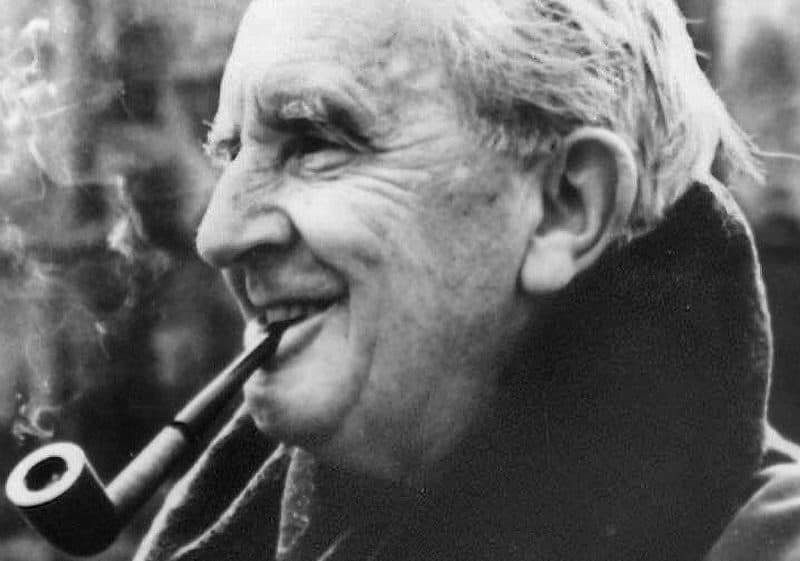R. R. Tolkien (1892-1973) and Frank Herbert (1920-1986) have written works that are among the greatest achievements of the literature of the fantastic, or speculative fiction. I have used these two terms as a bridge expression for the rather distinct genres of fantasy and science fiction.
Tolkien’s works are often collectively called “the Middle-Earth legendarium” or, more generally, the Arda mythos. Frank Herbert’s creation is commonly called “the Dune universe,” or, more colloquially the “Duniverse”. In this presentation, I will be looking mainly at J. R. R. Tolkien’s The Hobbit (1937) and The Lord of the Rings trilogy (originally published in three volumes in 1954-55), and Frank Herbert’s original Dune novel, first published in 1965.
Like many great classic works of dystopia, science fiction, or fantasy, these two works are largely driven by the specific invented terms and languages used in them. The driving impulse of the works under study is the “special languages” used in both of them.
The invention of language is a vital element of what Tolkien called the “subcreation” of a world, and it can be seen that both Tolkien and Herbert have placed an enormous amount of effort into the construction of specific vocabularies. Nearly all of the special words appear in the ongoing flow of the text, without being italicized. Of course, these special languages are not created ex nihilo – they are based on languages formerly used in human societies.
In his world-building, Tolkien went to great lengths to create extensive invented languages. His most prominent invented language, two varieties of Elvish – Quenya and Sindarin, — have been based largely on a combination of Latin, Old Norse, Old Anglo-Saxon, Celtic, and Finnish elements, to name the most prominent influences. It is at least somewhat interesting that the relation of the Elvish languages to the Middle-Earth setting at the time of the War of the Ring, is somewhat similar to that of Latin to the various European cultures in more modern times.
With regard to Frank Herbert’s Dune, the specific vocabularies used were based on at least three years of intensive study of Arabic, Persian, and Middle Eastern cultures generally, combined with other linguistic and cultural influences (such as Ancient Greek; South Asian — especially Mughal; East Asian; and Slavic).
Tolkien’s Lord of the Rings is said to be the archetypal work of fantasy in the modern period, or what has become termed “high fantasy”. Some have said that Tolkien both opened up and closed the high fantasy subgenre, as anything that follows him is likely to appear derivative. Dune is said to be among the greatest science fiction novels ever written.
Nevertheless, some have suggested that Dune might be a work that is “intermediary” between the genres of fantasy and science fiction. Certainly, some of the tropes used in Dune (such as the crone coming to test the young hero at the beginning of the novel) could easily fit into a work of fantasy. There are also such things as the social structures of the Duniverse being mostly feudal, and the fact that the technology is a mixture of the archaic and the advanced (for example, people fight knife-duels, but travel in spaceships across the galaxy). However, this melding of the archaic and advanced is extremely well thought-out and carefully constructed, so Dune can quite fairly be called science fiction.
The respective stances towards religion in the two bodies of work are rather different. Tolkien was in real life a devout Roman Catholic. It was his conscious intent to minimize the presence of fictive religions in The Lord of the Rings, relying on the general spirit of the work to convey a somewhat Catholic- and Christian-traditionalist sensibility. The Lord of the Rings trilogy ostensibly takes place in the remote past of our own Earth. Hence historical Christianity as such is not present in it.
Frank Herbert, who tended towards agnosticism, refers partially to “realworld” religions in Dune, although most of them have become transmogrified over millennia of human development into new, hybridized, syncretic beliefs. He uses such terms, for example, as “the Orange Catholic Bible”; “Zensunni”; and “bindu”. The predominant “realworld” context for his posited religions (especially in regard to the planet Dune itself) is Islam.
The two authors’ approaches to issues of good and evil differ somewhat. Tolkien portrays hordes of monstrous, evil creatures on the march against the forces of good. This does not correspond to any “realworld” situation – as the greatest enemies of men have been other men. Perhaps Tolkien’s point is that human beings in themselves, living in their human societies, have a choice to become either more like the demonic orcs — or more like the angelic elves. Also, in The Hobbit and The Lord of the Rings, Tolkien offers a typology of resistance to evil that does not explicitly invoke revealed religion – but at the same time valorizes such virtues as heroism, loyalty, friendship, and modest romantic love. Thus it opens up the possibility of making these virtues considerably attractive to those persons in late modernity who have fallen away from revealed religion, as well as those who are still believers.
In Frank Herbert’s Duniverse, there are in fact no malevolent aliens, but, rather, there are better and worse human beings. While Paul Atreides is shown as clearly, almost instinctually being able to distinguish between good and evil, he is also a conquering leader willing to apply force with little hesitation. In regard to Paul Atreides, one may indeed be reminded of Nietzsche’s stated ideal – that of “Caesar with the soul of Christ”. It is also somewhat reminiscent of the founder of Islam.
The vision enunciated by Tolkien could be termed as “pre-modern”. It hearkens back to the idealized Middle Ages of Christendom, to a world – as Tolkien put it — of “less noise and more green”. The vision enunciated by Herbert, on the other hand, could be termed as “post-modern”. It is a setting that, after millennia of future history, has left the modern world far behind.
Obviously, neither of the works arose ex nihilo. There was a societal and cultural context out of which the two works sprang, these being roughly-speaking Britain/England, and America, respectively. Tolkien was deeply shaped by pre-World War One Britain, a society where propriety and decorum and so-called civilized values were not yet out of fashion. That society was to be sorely tested by the Great War, in which Tolkien fought heroically. The original inspiration of the hobbits was said to be the ordinary British “Tommies” who were living in the trenches (“holes in the ground”) of the Great War — and rose to great levels of heroism, despite their preference for the simple comforts of home. This elevation of hobbits representing so-called ordinary people rising to extraordinary heights of courage is one of the main themes of The Hobbit and The Lord of the Rings.
At the same time, Tolkien had a profound appreciation for the element of hereditary monarchy and aristocracy in human existence, which he saw as being increasingly under attack in Britain. The Elves were clearly “natural aristocrats”. Also, part of the vision of Tolkien as a Catholic living in the British Isles was a sense of tragedy. For centuries since the time of Henry VIII, Roman Catholics had faced varying degrees of persecution in the British Isles, especially so under Oliver Cromwell. The fact that the Elves are increasingly harried and diminished throughout the unfolding of the Middle-Earth legendarium may be a reflection of this sense that Roman Catholicism was increasingly attenuated in the British Isles. As well, Oliver Cromwell could be seen as a possible inspiration for the figure of Sauron. Indeed, he might be considered a precursor to twentieth century tyrants like Hitler or Stalin.
Also, part of the Roman Catholic experience in the British Isles was identified with a yearning for the restoration of the Stuart dynasty, epitomized by the Jacobite Rising of 1745, led by Bonnie Prince Charlie (Charles Edward Stuart). For Roman Catholics and some Scots, the British Isles were seen as being under the occupation of a hostile, usurping dynasty (the Hanoverians). The romantic resonance behind the historical desire for a Stuart restoration may play a part in an over-arching theme of kingship in The Lord of the Rings (the third volume being significantly entitled, The Return of the King).
In the late nineteenth and early twentieth century, it was very possible for a tension of sentiment and feeling to exist between the person who wanted to be a quote “good Englishman” — and the person who wanted be a quote “good Roman Catholic” on the other. It could be argued that the dynamic arising from an attempt to effect a resolution of this tension was one of the origins of the Arda mythos.
Frank Herbert’s writing took its rise from America. He is more “modern” than Tolkien, more willing to look at religion in an “anthropological” way, as well as approaching ecological issues through a more systematic, scientific lens. Also, he is far more willing than Tolkien to look at civilizations and cultures other than the European, mirroring in this way what is usually America’s (this is true at least of some of America’s intellectual circles) greater openness to “the Other”.
Among the germs of Dune was a long non-fiction piece that Frank Herbert had been working on about sand dunes on the coast of California.
One of the central tropes of Herbert’s Dune is something that is clearly “realworld”. Herbert writes of the all-important quote “spice” that is the basis of interstellar space travel in the Dune universe. The sole source of the spice is the desert planet Dune, also called Arrakis. The local inhabitants of Dune are the warrior Fremen. One can easily transpose the reliance of the Dune universe on spice, to the reliance of our current-day Earth on oil – much of which is in fact located in the mostly sandy Middle East. Dune could be seen as a treatise on how a widely-spread human civilization can have an excessive reliance on a single resource – and how the local inhabitants of a single area are able to seize control of this resource from various hostile, occupying forces. Herbert’s Dune novels have apparently been quite popular in the Middle East.
Another central trope of Dune, that of the scientific approach to ecology – is also definitely “realworld”. The dedication of the novel reads: “To the people whose labors go beyond ideas into the realm of “real materials” – to the dry-land ecologists, wherever they may be, in whatever time they work, this effort at prediction is dedicated in humility and admiration.”
Neither Tolkien’s nor Herbert’s works arose without some precursors. Tolkien, for example, had read George Macdonald’s and William Morris’s fantasy works. Britain was also the locus for the Arthurian legends and their literary renderings. Tolkien also had high respect for Beowulf, the great Old Anglo-Saxon poem. Another influence was the epic poem “The Ballad of the White Horse” (1911) by G. K. Chesterton (1874-1936) portraying an idealized King Alfred. Much of Tolkien’s creativity was shaped by his interactions with the Inklings group, especially C. S. Lewis (1898-1963), whose own children’s fantasy series, The Chronicles of Narnia, appeared in seven volumes between 1950-1956 – beginning with The Lion, the Witch, and the Wardrobe.
As for Herbert, he could have been to some extent inspired by Isaac Asimov’s (1920-1992) Foundation Trilogy (originally published 1951-1953), and the attempts in the space-opera subgenre to meld archaic and advanced technology with feudal structures. A good example of the latter is “The Rebel of Valkyr” (1950), by Alfred Coppel (1921-2004) – which has been characterized as quote “horses in the starship hold”. However, in the typically written space-opera, this was done without close attention being paid to well-considered sociological and technological explanations for such a state of affairs.
Paul Atreides’ story is also somewhat similar to the exploits of Lawrence of Arabia, which have had an enormous impact on the Western imagination, as demonstrated, for example, in the superb 1962 movie on this gallant figure. There were also numerous late-nineteenth century stories where an exiled and disgraced European adventurer led “the natives” in Asia or Africa in a victorious war against their oppressors (who were either even greater savages, or supported by a rival imperial power) and thus regained recognition in his home country. A possible criticism of Herbert’s approach is that it may veer towards what Edward Said has called “Orientalism”.
Is it possible to see differences in American vs. British fantasy, and American vs. British science fiction?
It could be argued that the origins of American fantasy (as the term has become to be understood in more recent decades) were largely characterized by what later came to be called the “sword and sorcery” subgenre. This term could be applied in part to the Barsoom (Mars) series of Edgar Rice Burroughs (1875-1950), the first volume of which, A Princess of Mars, appeared in 1912. There were also the stories of Kull and Conan the Barbarian by Robert E. Howard (1906-1936), and the Lankhmar stories of Fafherd and Gray Mouser by Fritz Leiber (1910-1992). British fantasy appeared to be more literary, and, with Tolkien, was certainly given a major turn toward so-called “high fantasy.”
As for science fiction, this has often been conceived as a heavily American genre. Meanwhile, British science fiction was more distinctly literary, and embraced far fewer of what are considered the stereotypes of science fiction (such as monstrous aliens or malevolent robots menacing scantily-clad damsels in distress defended by rugged, stalwart heroes from Space Command). Indeed, probably the best known works of dystopian science fiction are Aldous Huxley’s Brave New World (1932), and George Orwell’s Nineteen Eighty-Four (1949). One of the writers of very philosophical science fiction in Britain was Olaf Stapledon (1886-1950).
While Tolkien’s writings enjoyed modest success in Britain, it was in America where they gained a truly mass audience, starting in the 1960s, and mushrooming exponentially after that. Somewhat ironically, Tolkien became one of the favorite writers of the so-called “hippie” movement. Rather generously for a traditionalist, he admitted that there were elements of the Sixties that he found highly congenial. In the 1970s, Tolkienian fantasy became the mainspring of fantasy role-playing games, typified by Dungeons and Dragons (released in 1974). Tolkien had sometimes expressed trepidation that his writing would become the basis for something like a cult.
J.R.R. Tolkien’s son Christopher has in the decades since his father’s death published in succeeding volumes virtually everything his father had ever written. These various papers and notes of J.R.R. Tolkien were so voluminous that there was no need to write new fiction based on the Arda mythos, to keep what became this mega-franchise in the public eye.
The first rendering of Tolkien on U.S. television was the 1977 animated version of The Hobbit. In 1978, Ralph Bakshi’s animated film, The Lord of the Rings (Part One) was released. (Although the studio left off the “Part One” suffix in the title, thus greatly confusing viewers.) Owing, among other factors, to the outcry of some fundamentalist Christians with respect to the quote “adult” animations he had worked on earlier, Bakshi was not allowed to finish this endeavor. In 1980, there appeared an animated version of The Return of the King, based on the third volume of The Lord of the Rings trilogy, by the same team who had brought out the 1977 Hobbit.
The two television efforts were not well-received, and there were no political inferences with regard to current world events that could be discerned from the three renderings.
In the years 2001 to 2003 The Lord of the Rings appeared in a trilogy format magnificently rendered by director Peter Jackson. These are acclaimed as some of the greatest movies ever made. The movies have also been made available at extended length (incorporating hours of extra footage) in DVD formats. Given the years in which they were released, the movies were often seen as expressing support for resolute American and Western opposition to the challenge from radical Islamists – who were most definitely seen as an embodiment of a radical evil that had to be decisively resisted.
In 1977, Simulations Publications Inc. (SPI), then one of the largest companies in its field, brought out the very colorful board wargame War of the Ring, with two smaller wargames, Sauron (about the battle at the end of Tolkien’s Second Age), and Gondor: The Siege of Minas Tirith (from the trilogy). In 1983, Iron Crown Enterprises (ICE ) brought out the boardgame, The Fellowship of the Ring. In 1984, ICE brought out the first volume of its Middle-Earth Role Playing system (MERP), which became probably the second-most-popular role-playing game (after Dungeons and Dragons). ICE produced various supplements and elegantly rendered stand-alone maps until 1999, when Tolkien Enterprises unceremoniously yanked its franchise rights. ICE went bankrupt the next year.
Frank Herbert published, it may be noted, five sequel novels to Dune before his death in 1986, thus bringing the extant canon to six volumes.
Frank Herbert’s son Brian, usually with the help of Kevin J. Anderson (known mainly as the author of novels in the Star Wars franchise) has in more recent decades been churning out books of fiction based on the Duniverse. Some of these are said to be based on Frank Herbert’s fragmentary notes. The son’s efforts have had a very mixed reaction from longtime Frank Herbert fans.
In 1984, a lavishly budgeted film based on Dune, directed by David Lynch, was released. It was not seen as the best of all possible renditions — and indeed introduced many deviations in regard to the original vision of the book. For example, in the book, Baron Harkonnen is a kind of „Mephistophelean” figure, but is rendered as a hideous horror-flick „monster” in the film. Lynch also introduced various other ugly elements of horror that do not have much basis in the book. And the black rubber still-suits (desert gear) are laughably wrong.
In December 2000, there appeared a new rendering of Frank Herbert’s Dune, as a six-hour television mini-series on the U.S. Sci-Fi Channel. This seemed like a more graceful adaptation of the book, and the various East European actors playing in the movie (alongside mostly British actors) gave it a nice touch. The mini-series is available on DVD in a “Director’s Cut” – which is essentially the version of the mini-series shown internationally. Apparently the rules regarding what can be shown on U.S. television required some cuts to the American version as opposed to the version shown internationally.
Nevertheless, some have argued that some of the costuming was better in Lynch’s version – notably the dress of the Bene Gesserit (the all-female religious order).
The political import of the 1984 movie and 2000 television mini-series – in relation to currently-occurring world events — was rather minimal.
Among the most prominent board wargames based on Dune are Avalon Hill’s 1979 multiplayer game (second edition, 1984, with two modules – Spice Harvest and The Duel). Also released in 1984 was Parker Brothers’ Dune boardgame. Dune has not been prominent as a roleplaying background. Indeed, the roleplaying game Fading Suns (1996), an independent setting which is nevertheless somewhat based on the Duniverse, probably exceeds in popularity any role-playing games based specifically on Dune. It might be concluded that the holders of the franchise have not been too astute as far as gaming products go.
What are the main differences between the visions of Tolkien and Herbert?
Tolkien seemed to look backward to the past in a defence of an Old England. Herbert boldly looked to a future consisting of what has been characterized as “feudal values plus high technology”. The origins of this term stem from the year 1985, when the prominent left-wing science fiction writer, Judith Merril (1923-1997), had ruefully complained that most of science fiction appeared to be characterized by such a typology.
It could be argued that Tolkien’s writing remained entirely circumscribed by the context of his British and European roots. It could be noted, for example, that the political geography of Middle Earth is almost entirely that of historical Europe. The forces of freedom, for example, are centered in the west, while the invasions come from the south and the east.
What has been called Herbert’s “anthropological” outlook gave him the opportunity step outside the “West” and entertain Islamic and “Eastern” outlooks.
While Tolkien’s work can certainly inspire ecological and cultural resistance to the more negative aspects of late modernity, Herbert’s work can be seen as being more akin to prophecy, suggesting the ways in which traditional ethos might be able to persist in societies of very highly advanced technology.
Mark Wegierski



